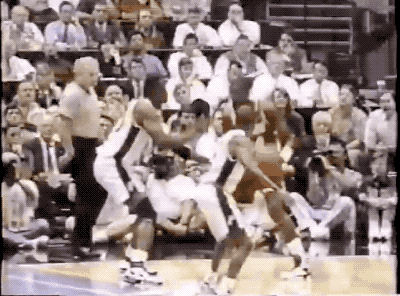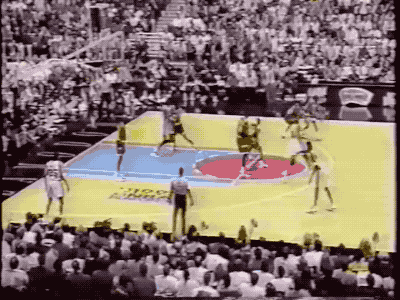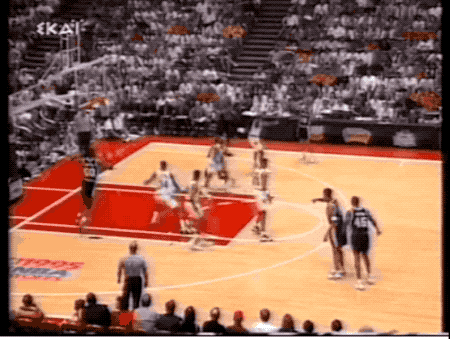There's no "I" in team. There is in "team win"
Hakeem Olajuwon, David Robinson, and why basketball is simultaneously a team sport and an individual one.


“The concept may be team. In reality, it’s the individual.”
Those were Marv Albert’s words to promote a 1996 Bulls-Knicks playoff game on NBC. They’ve been stuck in my head for longer than I can remember.
In context, that 10-word phrase was a blunt, yet effective device to introduce another chapter in the story of Michael Jordan’s ongoing playoff domination of Patrick Ewing. (The Knicks happened to win this game, but lost the series to the Bulls in five).
But it also conveyed what many see as the central tension of basketball. Is it a team game where everyone plays an essential role, or is it a performance where a select few rise above to determine the outcome on their own? Did the Bulls beat the Knicks because they had a better team, or did they win because Michael Jordan was a much better individual than Patrick Ewing?
The NBA’s legacy of selling itself as a league of stars further muddies the waters. The concept, according to the league’s broadcast partner, is team. In reality, the Knicks’ fate rests with the individual. That seeps its way into the wider coverage of the league. What generates more interest: lists ranking the greatest players of all time or the greatest teams of all time? Ask anyone who works for a media company, and you’ll get the same answer.
So what is it, then? Is pro basketball only a team game conceptually? Is it actually a game of individuals? Which framing merits more attention when telling the story of the NBA?
The answer is both … and neither. To illustrate the point, let’s take a look back at a moment in history that’s remembered as a battle between two individuals.
The 1995 Western Conference Finals is seen as Hakeem Olajuwon’s triumph over David Robinson. Fueled by the image of Robinson receiving the MVP award before one of the early games in the series, Olajuwon dominated in spectacular fashion, leading Houston to a six-game upset victory. This selectively edited three-minute excerpt from “Double Clutch,” the NBA’s official home video commemorating Houston’s 1995 title, has been viewed 3.2 million times on YouTube. It’s title: “Olajuwon dominates Robinson.”
Conceptually, the Rockets beat the Spurs. In the league-produced retelling, one individual star triumphed over another.
The reality is that both statements are true and caused each other. The great irony is the team that tried to turn the series into an individual battle is the one that ended up losing.
Robinson and Hakeem weren’t competing on equal playing fields. That was by the Spurs’ design
The Rockets relied on a simple offensive formula: Hakeem + shooting = pick your poison. Their collective spacing lubricated Olajuwon’s endless series of twirling post moves, especially in 1995 with Clyde Drexler instead of Otis Thorpe. Their path to victory was to make defenses choose between Olajuwon and their shooters.
Most teams chose Olajuwon, swarming him with double- and triple-teams while allowing the other guys more open looks from downtown. Hakeem was the Rockets’ main shot creator, with Drexler a distant second and Sammy Smithssell a more distant third. (To be clear: that’s the point guard combination of Kenny Smith and Sam Cassell). In a perfect world, cutting off Olajuwon’s share also means shutting down the supply lines the other Rockets needed to score. That’s why Seattle’s SOS system gave Houston trouble during these years.
But the Spurs took the opposite approach. “Unlike most teams that double up on Olajuwon, the Spurs will allow David Robinson to play him one on one,” TNT analyst Jack Givens said in the opening minutes of the Game 1 telecast. “Bob Hill said he’s more concerned with the outside shooting of Houston – the three-point shooters on this team.”
Here’s what that looked like in practice.

Olajuwon caught the ball in his wheelhouse, yet only one Spurs player is focused on him. The other four are paying full attention to their assignments. Eight spectators watching Robinson defending Olajuwon. A battle of … individuals.

The Spurs’ logic was that Robinson wasn’t like the other centers Olajuwon repeatedly bamboozled. The Admiral was the MVP and a defensive powerhouse. He wasn’t the kind of stiff Olajuwon regularly devoured. If Robinson could hold Olajuwon slightly below his regular efficiency by himself, San Antonio could defy the Rockets’ normal formula, just in the opposite direction. They’d make Houston role players go silent, and Olajuwon wouldn’t be able to make up the difference himself.
The Spurs had proof the strategy could work, having won five of six against the Rockets in the regular season while using a version of the “no double” system. Olajuwon scored nearly 30 a game, but was below his usual efficiency and above his normal usage. The Spurs dared Olajuwon to beat them himself, and he couldn’t.
So they did it again to start the series. Here’s how that went in the first two games.

Yeah.

Oof.

Too late.

So that backfired.
The worst part is that the Spurs didn’t stop the other Rockets either. Olajuwon knew he had space to operate, so he made his moves in rhythm without fear of other Spurs getting in the way. Only after Olajuwon got into the lane did the Spurs suck in, and that’s far too late. By then, Olajuwon could read the help and find open teammates on the move. This three missed, but this was not the kind of perimeter look the Spurs want to give up.

Turns out it was the Spurs’ plan to make the series a battle between two individuals and eight other dudes. They figured their remaining four would easily outplay Houston’s invisible four, giving them the overall edge.
That works as long as the two individuals canceled each other out. The problem was that they didn’t. Hakeem was that good.
It also didn’t work because Houston took the opposite approach with Robinson.
The Spurs gave Olajuwon all sorts of space to go at Robinson. They wanted Houston to think the series was about the individual.
The Rockets, on the other hand, used their entire team to slow the MVP. They did not give Robinson the same liberty to attack, swarming him as soon as he caught the ball and pre-rotating to the help positions to cut off easy passes out of double teams. They did not let Robinson wage an individual battle against Olajuwon on equal terms.
This is what a typical Robinson post-up looked like.

When Robinson shot anyway, it was with multiple bodies sitting in his lap.

Houston’s plan began with a decidedly modern tactic: roaming off a non-shooting perimeter player to muck up space elsewhere. That player was pint-sized San Antonio point guard Avery Johnson, San Antonio’s crucial playmaker who lacked range and consistency on his jump shot. Think of Johnson as a retro version of Milwaukee’s Eric Bledsoe, a wonderful regular-season player who struggles in the playoffs when teams ignore him to help on Giannis Antetokounmpo.
Houston’s goal was to get Johnson to shoot the ball as much as possible. When Johnson dumped the ball in the post, his man – usually Cassell or Smith – zoned up on Robinson.

When Johnson ran pick-and-roll, the Rockets went under the screen. Wayyyyy under the screen, in fact.

When Johnson stood on the opposite side, the Rockets used his man to double-team Robinson and shifted the rest of their players over to cover the other four Spurs. If a different Spurs ball-handler ran pick-and-roll, Johnson’s man became the extra body standing in the middle of the free-throw line.

Cassell and Smith weren’t the most physically imposing players, but they didn’t double-team to get the steal themselves. They came with arms raised, planting themselves where they thought Robinson would go rather than coming all the way to him. Because their double-teaming off Johnson was part of a larger strategy to close space, the other Rockets moved along with them as if they were tied together on a string.

The Rockets’ goal was to force players like Johnson, Doc Rivers, and Vinny Del Negro to shoot instead of Robinson. They continued their strategy even when Rivers, a more proficient outside shooter, replaced Johnson at the point.

This turned the Spurs’ offense into a more equal-opportunity unit instead of the Robinson-centric one that led San Antonio to 62 wins in the regular season. Robinson’s usage rate – the percentage of Spurs possessions he ended with a shot, turnover, or drawn foul while on the floor – fell from 29.9 percent in the regular season to 28.5 in the series. Meanwhile, Johnson’s and Del Negro’s usage rates went up, while Rivers’ skyrocketed from 17.6 in the regular season to 24.4 in the series. Johnson had terrific individual numbers – 16 points and 7.5 assists on a team-leading 55.5-percent true shooting mark – but Houston maintained its strategy. The points Johnson scored were more than counteracted by the space the Rockets were able to limit by ignoring him.
It’s true that Robinson has fewer post moves in his bag than Olajuwon, relying more on power and a quick first step. It’s also true that San Antonio lacked the three-point shooting that could’ve given Robinson more room to maneuver. (They did have the best offensive rebounder on the planet in Dennis Rodman, who should’ve feasted given the Rockets’ scrambled defensive rotations. We’ll get to him shortly).
But this is why comparing Robinson and Olajuwon’s production in the series, as so many did at the time and after the fact, is misleading. They didn’t have the same opportunity to produce big numbers because of the two teams’ strategies to contain them. Their individual battle played out within larger team contexts designed to make them play in wildly different ways.
Those were the baseline strategies. How did the two teams adjust them throughout the series?
Remember, this was no Houston blowout. After winning the first two games in San Antonio, the Rockets strangely dropped two straight games at home. Even weirder: they dominated Game 5 again in San Antonio before holding on in Game 6 to take the series. That all happened because both teams made critical chess moves to alter, but not scrap, their original plans.
In Games 3 and 4, the Spurs sprinkled in a few more double-teams to limit Olajuwon. Their perimeter players came a bit sooner on the help and swiped at the ball to throw off Olajuwon’s rhythm. They were able to create the effect of a double team without needing to fully commit to it.
Johnson’s quick feet and hands made him an ideal fit for the task. He could come down when Smith or Cassell threw the entry pass and still close out on them on the same side if Olajuwon kicked the ball back out.

Olajuwon still got his shots off, but was forced to use secondary moves more often than in the first two games. (He was excellent in Game 3’s close defeat, but fell silent in Game 4’s blowout). The threat of the Spurs’ distraction tactics made Olajuwon more tentative. Meanwhile, the other Rockets lost their poise in Game 4, with turnovers and rushed shots that triggered Spurs fast breaks.
On the other end, San Antonio made Robinson more of a decoy. They used Robinson as a pick-and-roll screener more often, knowing Olajuwon or Charles Jones wouldn’t dare trap the ball-handler and leave Robinson open.

They also positioned Johnson closer to the basket when Robinson had the ball. The Rockets wanted Johnson shooting 16-foot jumpers, not layups. By keeping him one step from the rim, Houston had to pay more attention to him. That opened lanes for other Spurs.

But instead of abandoning their principles, the Rockets doubled down even further on space and swarm. Rudy Tomjanovich had started Pete Chilcutt or Chucky Brown in the first four games to combat Rodman’s rebounding. In Game 5, he started ace sixth man Mario Elie and swung Robert Horry up to power forward. That move further spread San Antonio out on offense and gave the Rockets a better matchup for Sean Elliott on the other end.
The knock-on effect was that Rodman now had to guard Horry full-time, which benefited Houston. Rodman’s job on that Spurs team was to stay around the basket, snag defensive rebounds, and push tempo a la Draymond Green. His natural inclination was to drift inside because that’s where all the rebounds were. Those lapses didn’t cost the Spurs when Rodman was on Brown, Chilcutt, or Charles Jones, but it did when he had to check a proficient outside shooter and cutter like Horry. (It helped that Rodman’s relationship with the Spurs was disintegrating. Spurs coach Bob Hill benched him at the start of Game 5 for being late to practice, and the rest is history).

That lineup adjustment changed the geometry of the floor. Now, Smith or Cassell could clear out to the other side after dumping the ball to Hakeem, taking pesky double-teamer Johnson with them. Because of that, those decoy double-teams on Olajuwon required more coordination than the Spurs were able to handle. They couldn’t limit Olajuwon and also shutting down Houston’s perimeter shooting.

Meanwhile, Houston went even further with their roaming defensive strategy. Now, they ignored Johnson and Rodman liberally. That gave them more resources to devote to San Antonio’s side pick-and-roll while still limiting Robinson’s space.

The risk was giving Rodman freer reign on the offensive glass, but Houston solved that problem with aggressive gang rebounding from their wings. The Rockets actually grabbed a higher percentage of available offensive rebounds than the Spurs did in the final two games of the series despite downsizing their lineup. Surprised? Don’t be. It’s the same reason the Warriors dominated the 2015 NBA Finals once they moved Andre Iguodala in the starting lineup in place of Andrew Bogut. In trading size for speed, Houston enabled a style that featured more long rebounds and fewer chances for Rodman to wedge his man underneath the basket.
That’s how the Rockets pulled off the upset.
Let’s sum this up one more time:
The Spurs tried to get the Rockets to engage in an individual duel while sidelining their other four players.
Houston accepted, but also altered their team strategy to rig the battle in favor of their guy.
The Spurs reacted by pulling back the one-on-one duel and beating Houston as a collective.
The Rockets went even further, using different lineup combinations and floor spacing to tip the crucial individual battle back overwhelmingly in their favor.
Houston won the series and Olajuwon outproduced Robinson.
In other words, the Rockets beat the Spurs by dominating the individual battle the Spurs tried to engineer. The concept is team. In reality, it’s the individual? Turns out that’s a false dichotomy.
That’s why the NBA can be so compelling for casuals and diehards alike. The team works together to enhance their most critical individual and limit their opponent’s. Olajuwon did outplay Robinson, and that did decide the series. It was a moment that vaulted Olajuwon ahead of Robinson on the list of the game’s greatest players. But it also wouldn’t have happened without the other Rockets clearing space for him on offense and collectively flooding the paint to limit his foe on defense.
The concept was team. History credits the individual. In reality, basketball is always about both.


Mike, thanks for the article. Great as always. The Rockets' strategy was close to illegal defense, right? Players are not fully committed to their assignment in a couple of gifs. Especially the Drexler one.